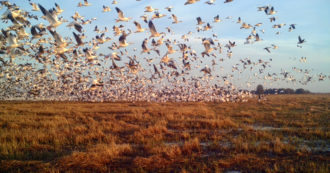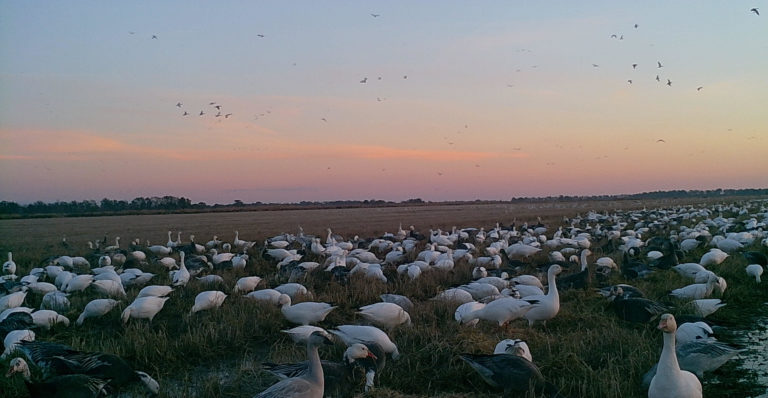STARKVILLE, Mississippi – Rice, for all of its importance as a global food staple, can have a number of environmental tradeoffs. Intensively managed, the crop can put a strain on natural resources, particularly soil and water. But a more sustainable production system may enhance environmental quality at an economic gain for the farmer, based on the results of a Mississippi State University study.
Beth Baker, an MSU Extension assistant professor in the Department of Wildlife, Fisheries, and Aquaculture, along with graduate student Alexandra Firth, compared conventional rice production practices to low-external-input on fields in the Mississippi Alluvial Valley, one of three major rice-growing regions in the U.S.
Low-external-input sustainable agriculture (LEISA) is a practice that reduces external inputs by utilizing ecosystem resources. In the case of the MSU study, researchers flooded rice fields over winter creating a wetland-like habitat to reduce tillage practices, attract bird populations, and address soil health, water quality and nutrient run-off. In conventional rice production, fields are drained once rice is ready to be harvested and then left fallow during the non-growing season. Some producers do practice winter flooding of rice fields to create habitat for migrating birds, but less research has focused on the subsequent impacts of bird use on soil and water quality.
“We hypothesized that the annual flooding of rice fields to create water bird habitat would benefit soil health and water quality and increase avian biodiversity, as well as provide agronomic benefits to the farmer,” said Firth.
The researchers selected 10 fields ranging from 24 to 100 acres and categorized them as LEISA flooded, LEISA non-flooded, conventional flooded and conventional non-flooded. They conducted bird surveys and tests to measure soil health, water quality, and pathogen loads from bird waste.
The project uncovered a number of results that point to the benefits of a low-external-input system in rice production:
- Winter-flooded fields increase soil quality by attracting higher migratory bird populations, which then produce higher amounts of bird waste. That waste increases microbial activity and diversity in rice soils. “Experimentally flooded rice amassed approximately 2.8 times more fecal inputs in low-input flooded fields than in the low-input non-flooded fields. First-year flooded fields from the conventional farm collected 2.5 times more fecal matter than their non-flooded counterpart,” said Firth. “Low-input flooded fields had statistically greater fecal matter inputs than the conventional fields. Previous studies have shown that birds prefer rice fields that leave standing rice straw beyond the non-growing season. As the LEISA farm practices no-till, this will likely increase bird activity.”
- Bird waste can replace a portion of nitrogen fertilizer application. “An increase in bird activity in low-input flooded fields is correlated with an increase in nitrogen loads, with fecal input potentially replacing a third of the total recommended nitrogen fertilizer application,” said Firth. “This could provide an incentive for the farmer to winter flood.”
- Low-input fields increase carbon sequestration in the soil by storing more carbon,compared to the conventional rice fields. “The LEISA system practices no-till management, which is known to increase soil organic carbon and mimic the process of carbon sequestration,” said Firth.
- Higher bird populations contribute to higher percentages of soil carbon. “Water birds in rice fields break up standing rice straw and incorporate it into the soil as they forage for food,” said Firth. “Higher densities of birds will increase the contact rice stubble has with the soil which increases decomposition and consequently soil carbon.”
- Low-input fields, whether flooded or non-flooded, improve water quality by slowing the rate of nutrient run-off compared to conventional fields. “Unlike LEISA soils, the conventional soils have a life history of regular tillage,” said Firth. “Intensive tillage practices fracture the soil, disturb soil structure, and can accelerate surface runoff and soil erosion.”
- Low-input fields in the study used less fertilizer and chemicals, as well as had lower planting costs, compared to conventional fields. Rice yields in the low-input fields were lower than the conventional rice fields. However, factoring in farming expenses, low-input fields had a greater net gain per acre of rice than the conventional fields.
Researchers also found that pathogen load from bird waste in the low-input fields was not statistically significant, allaying any public health concerns.
It was noted that flooded LEISA fields could have higher methane emissions, an environmental drawback for farmers who desire to use the system. “Rice production creates a carbon conundrum that consists of a series of tradeoffs between soil health and greenhouse gas emissions that neither the LEISA nor conventional system resolve,” said Firth. “Further research on the interaction of this complex system is needed to make future environmentally conscience management decisions.”
Overall, low-external-input sustainable agriculture is an option for rice farmers interested in soil and water health, and conservation practices, while potentially improving their bottom line. However, the uniqueness of the LIESA system and intensive nature of the field research limited scaling the research across many farms, and the researchers note that more research is warranted.
More information on the results of the Southern SARE Graduate Student study (GS17-166), “Investigation of a Low-external-input Sustainable Rice Production System to Identify Ecosystem Services Towards Adoption Costs and Benefits,” are available by visiting the SARE Projects Database.
Published by the Southern Region of the Sustainable Agriculture Research and Education (SARE) program. Funded by the USDA National Institute of Food and Agriculture (NIFA), Southern SARE operates under cooperative agreements with the University of Georgia, Fort Valley State University, and the Kerr Center for Sustainable Agriculture to offer competitive grants to advance sustainable agriculture in America's Southern region. This material is based upon work that is supported by the National Institute of Food and Agriculture, U.S. Department of Agriculture, through Southern Sustainable Agriculture Research and Education, under sub-award number: GS17-166. USDA is an equal opportunity employer and service provider. Any opinions, findings, conclusions, or recommendations expressed in this publication are those of the author(s) and do not necessarily reflect the view of the U.S. Department of Agriculture.

